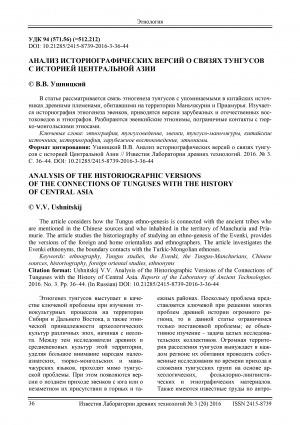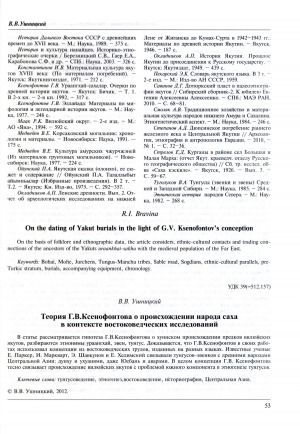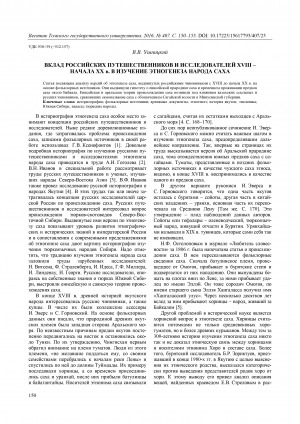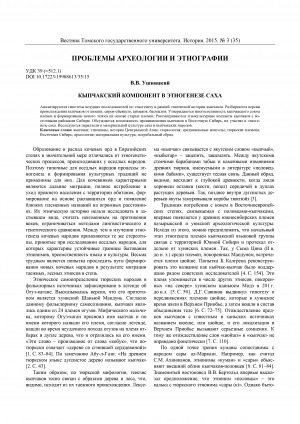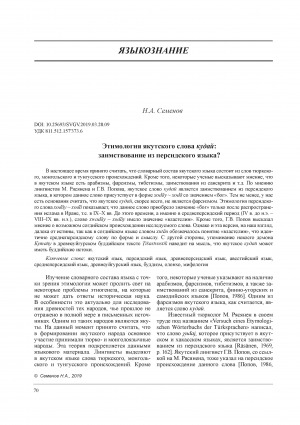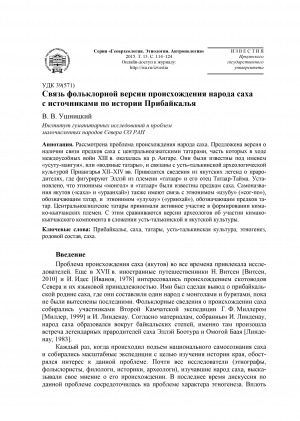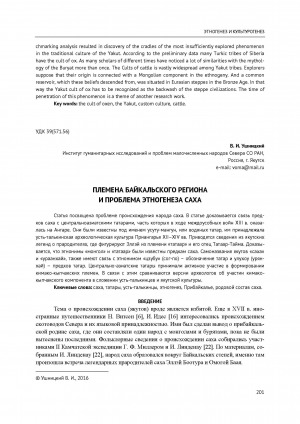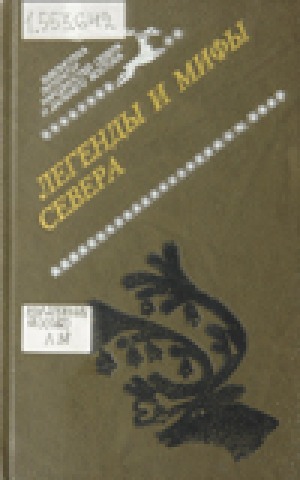Tatars of Central Asia and the Problem of Origin of the People Uraanghai-Sakha

Татары Центральной Азии и проблема происхождения народа ураангхай-саха
Tatars of Central Asia and the Problem of Origin of the People Uraanghai-Sakha
Статья в журнале
Русский
Библиогр.: с. 34-35 (47 назв.)
94(=512.145)+94(=512/157)
Центральная Азия; этногенез; кочевые народы; средневековые татары; тюркология; народ саха; историография; монголоведение; китайские источники; рунические памятники; фольклор; арабо-персидские летописи; Монгольская империя; Прибайкалье; Central Asia; ethnogenesis; nomadic peoples; Middle Ages; medieval Tatars; turkology; Sakha people; historiography; Mongolian studies; Chinese sources; runic monuments; folklore; Arab-Persian chronicles; Mongolian Empire; Baical region
История. Исторические науки / Этнография и историческая антропология
Северо-Восточный гуманитарный вестник. – 2017. – N 3 (20)
С. 30-36
Северо-Восточный гуманитарный вестник
Якутск, Федеральное государственное бюджетное учреждение науки Институт гуманитарных исследований и проблем малочисленных народов Севера Сибирского отделения Российской академии наук
2218-1644 (print)
Журнал включен: РИНЦ
РИНЦ ИФ_2017: 0,175
The article is devoted to the interpretation of the concept of the Tatar origin of the Sakha people. This opinion is prompted by the analysis of the legends about the forefathers of the people Omogoe and Ellaei and the historiography of the question. In Yakut folklore, as the ancestors of Sakha are mentioned “Tataars” and a man named Tataar-taima, who is considered the father of Ellaei. This article analyzes information about the Central Asian Tatars found in the Ancient Turkic runic inscriptions, in the Chinese sources of the Tang, Song, Lyao, and Jin dynasties. In the writings of Rashid al-Din, they act as a mighty tribe that had previously dominated Central Asia. Mahmudal-Kashgari refers the Central Asian Tatars to the Turkic-speaking peoples who have their own language. S.G. Klyashtorny and Yu.A. Zuyev after studying the information of runic monuments and Chinese sources of different dynasties came to the conclusion that in the ethnogenesis of the Buir Nur Tatars took place also Heihez-Shiwei, i.e. cart Kanglies and Iranian-speaking Sogdians - sog-po. Kangly in the Buir Nura Tatars are compared with the Kangalas among the Sakha. Indo-, Iranian-speaking component in Sakha may be traced back to the participation of Iranian component in the ethnogenesis of the Central Asian Tatars. In the works of Abulgazi and Rashid-ad-Din there is news of the flight of the remains of Tatars to the Angara River. These messages are identified with the folklore sources of the sakha about the flight of people from the tribe “tataar”, defeated in the war against the people of “nuucha”. Proto-Yakutian Ust-Tal'kin archeological culture of the 12th - 14th centuries in the Southern Priangarie it is associated with the usutu-mangun tribe. The ethnonym Usutu-mangun is reconstructed as water Mongols. This tribe, according to European travelers, is identical to the tribe of the Tatars. The ethnonym of the Mongol was one of the ancient self-names of Sakha. In the Angara Tatars or Alakchin there was a Manga region, whose name is similar to the name of the Yakut ulus Mange. Folklore, linguistic, ethnographic and anthropological data testify to the common ancestors of Sakha and Buryat-Bulagat. This coincides with the conclusion of archaeologists that the Ust-Tal'kin culture simultaneously belongs to the Mongolian ancestors of the Buryats - the Bulagat tribe, and the Turkic-speaking Sakha ancestors.
Ушницкий, В. В. Татары Центральной Азии и проблема происхождения народа ураангхай-саха / В. В. Ушницкий // Северо-Восточный гуманитарный вестник. — 2017. — N 3 (20). — С. 30-36.
Чтение документа возможно в помещении библиотеки
